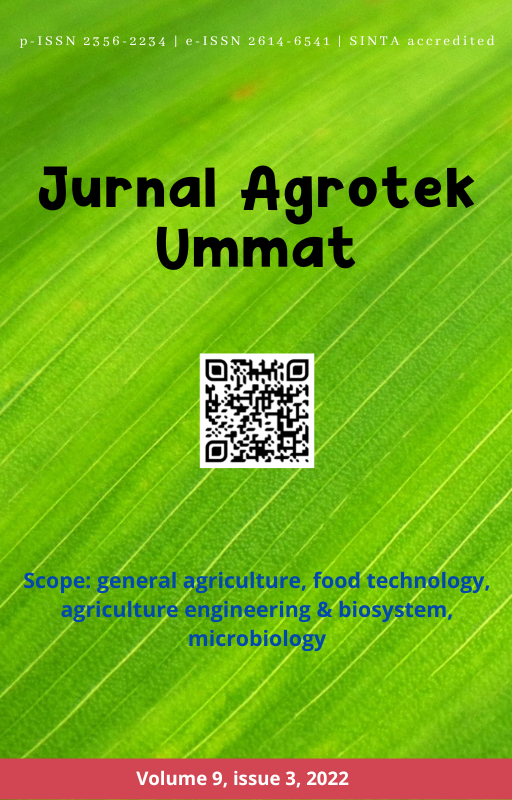The effect of fermentation time on bioethanol levels from sugar cane (saccharum officinarum)
DOI:
https://doi.org/10.31764/jau.v9i3.8106Keywords:
Bioethanol, Fermentation, SugarcaneAbstract
High energy consumption has an impact on the crisis caused by the decline in fossil energy reserves, so that Indonesia must have other energy alternatives in the form of biofuels, namely bioethanol. Knowing the effect of fermentation time on ethanol content, pH value, and brix content obtained from sugarcane juice is the purpose of this study. Using completely randomized design (CRD) with fermentation time factor. Research shows that fermentation time has an effect on ethanol content and acidity (pH), but has no effect on sugar content (brix). The best treatment was obtained at 6 days of fermentation with ethanol content of 7.67%, acidity (pH) 4.87%, and sugar content (brix) 6.33%. the ratio of high and low amount of ethanol produced is influenced by sugar consumption and yeast growth during the fermentation process.
References
Aini, A. F., Saripah, Manfaati, R., & Hariyadi, T. (2021). Pengaruh Suhu Lingkungan dan Waktu Fermentasi Biji Kopi Arabika Terhadap Kadar Kafein, Etanol, dan pH. Prosiding The 12th Industrial Research Workshop and National Seminar, 4–5.
Anggraini, S. A., Yuniningsih, S., & Sota, M. M. (2017). Pengaruh Ph Terhadap Kualitas Produk Etanol Dari Molasses Melalui Proses Fermentasi. Jurnal Reka Buana, 2(2), 99–105.
Arif, A. Bin, Budiyanto, A. ., Diyono, W. ., & Richana, N. . (2018). Optimasi waktu fermentasi produksi bioetanol dari dedak sorghum manis (sorghum bicolor l) melalui proses enzimatis. Jurnal Penelitian Pascapanen Pertanian, 14(2), 67. https://doi.org/10.21082/jpasca.v14n2.2017.67-78
Kerina, D. Y., Studi, P., Lingkungan, T., Teknik, F., Malahayati, U., & Lampung, B. (2022). Fermentasi bioethanol dari bahan baku biji buah- buahan menggunakan ragi roti dan ragi tape. 5(April), 24–34.
Khodijah, S., & Abtokhi, A. (2015). Analisis Pengaruh Variasi Persentase Ragi (Saccharomyces Cerevisiae) Dan Waktu Pada Proses Fermentasi Dalam Pemanfaatan Duckweed (Lemna Minor) Sebagai Bioetanol. Jurnal Neutrino, 71. https://doi.org/10.18860/neu.v0i0.2989
Kurniati, Y., Khasanah, I. E., & Firdaus, K. (2021). Kajian Pembuatan Bioetanol dari Limbah Kulit Nanas (Ananas comosus. L). Jurnal Teknik Kimia USU, 10(2), 95–101. https://doi.org/10.32734/jtk.v10i2.6603
Muin, R., Hakim, I., Febriyansyah, A., Teknik, J., Fakultas, K., Universitas, T., Aking, N., & Enzim, K. (2015). Enzim Terhadap Kadarbioetanol Dalam Proses Fermentasi Nasi Aking Sebagai Substratorganik. Jurnal Teknik Kimia, 21(3), 56–66.
Noor, E., Nofa, M. I., & Arya, A. C. (2016). Prosiding Seminar Nasional Aplikasi Sains & Teknologi (SNAST) Yogyakarta, 26 November 2016 ISSN : 1979 – 911X eISSN : 2541 – 528X. Jurnal SNAST, November, 383–391.
Pramudya, Y., Sigit, S., Pamungkas, T., Studi, P., & Tanaman, B. (2022). Studi Respon Cekaman Garam Terhadap Kondisi Tanaman Tebu ( Saccharum officinarum ) Study of Salt Stress Response to Sugarcane ( Saccharum officinarum ) Conditions. Open Science and Technology, 02(01), 109–116.
Statistik, B. P. (2013). Nusa tenggara barat dalam angka. In badan pusat statistik.
Taslim, M., Mailoa, M., & Rijal, M. (2017). PENGARUH pH, DAN LAMA FERMENTASI TERHADAP PRODUKSI ETHANOL DARI Sargassum crassifolium. Biosel: Biology Science and Education, 6(1), 13. https://doi.org/10.33477/bs.v6i1.129
Teixeira, F. S., Vidigal, S. S. M. P., Pimentel, L. L., Costa, P. T., Pintado, M. E., & RodrÃguez-Alcalá, L. M. (2021). Bioactive sugarcane lipids in a circular economy context. Foods, 10(5). https://doi.org/10.3390/foods10051125
Wardani, A. K. (2018). Pengaruh Lama Waktu Fermentasi pada Pembuatan Bioetanol dari Sargassum sp Menggunakan Metode Hidrolisis Asam dan Fermentasi Menggunakan Mikroba Asosiasi (Zymomonas mobilis, Saccharomyces cerevisiae dalam Ragi Tape dan Ragi Roti ). In Universitas Sanata Dharma, Yogyakarta. (Issue Skripsi).
Wong, Y. C., & Sanggari, V. (2014). Bioethanol production from sugarcane bagasse using fermentation process. Oriental Journal of Chemistry, 30(2), 507–513. https://doi.org/10.13005/ojc/300214
Xie, J., Weng, Q., Ye, G., Luo, S., Zhu, R., Zhang, A., Chen, X., & Lin, C. (2014). Bioethanol Production from Sugarcane Grown in Heavy Metal-Contaminated Soils. BioResources, 9(2), 2509–2520. https://doi.org/10.15376/biores.9.2.2509-2520
Zabed, H., Faruq, G., Sahu, J. N., Azirun, M. S., Hashim, R., & Nasrulhaq Boyce, A. (2014). Bioethanol production from fermentable sugar juice. The Scientific World Journal, 2014. https://doi.org/10.1155/2014/957102
Downloads
Published
Issue
Section
License
Authors who publish articles in Jurnal Agrotek Ummatagree to the following terms:- Authors retain copyright of the article and grant the journal right of first publication with the work simultaneously licensed under a CC-BY-SA or The Creative Commons Attribution–ShareAlike License.
- Authors are able to enter into separate, additional contractual arrangements for the non-exclusive distribution of the journal's published version of the work (e.g., post it to an institutional repository or publish it in a book), with an acknowledgment of its initial publication in this journal.
- Authors are permitted and encouraged to post their work online (e.g., in institutional repositories or on their website) prior to and during the submission process, as it can lead to productive exchanges, as well as earlier and greater citation of published work (See The Effect of Open Access).

